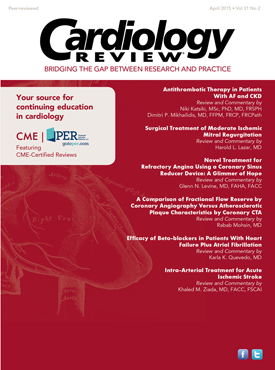Publication
Article
Cardiology Review® Online
Illuminating Clinical Conundrums
Author(s):
After a brutal winter, particularly for those in the Midwest and on the East Coast, spring is finally in the air. I hope everyone had a nice spring break with their families and is eager to read some insightful material on cardiology.

Debabrata Mukherjee
Editor in Chief
After a brutal winter, particularly for those in the Midwest and on the East Coast, spring is finally in the air. I hope everyone had a nice spring break with their families and is eager to read some insightful material on cardiology.
We touch on several clinical conundrums in this issue that I am sure our readers will find illuminating. Dr Glenn Levine discusses a novel treatment for refractory angina using a coronary sinus reducer device. He suggests that at present, first-line therapy for angina remains beta-blockers, nitrates, and calcium channel blockers and newer pharmacotherapies including ranolazine, ivabradine, and nicorandil in some patients. The role of novel mechanical interventions remains to be determined, although the results of the coronary sinus reducer trial provide at least a glimmer of hope to the growing number of patients with refractory angina.
Drs Niki Katsiki and Dimitri Mikhailidis delve into antithrombotic therapy in patients with atrial fibrillation and chronic kidney disease. They state that chronic kidney disease is associated with a higher risk of stroke in atrial fibrillation patients and that warfarin had a significant net clinical benefit in high-risk patients as well as in both low/intermediate- and high-risk patients with non—end-stage chronic kidney disease. Whether chronic kidney disease should be added to the atrial fibrillation risk score remains to be established in future studies.
Dr Harold Lazar discusses surgical treatment of moderate ischemic mitral regurgitation and informs us that bypass surgery alone may be all that is necessary for patients with coronary artery disease and moderate ischemic mitral regurgitation. However, a larger trial, significantly powered to assess clinical end points over at least a 3-year period, is needed to change guidelines.
Dr Karla Quevedo evaluates the efficacy of beta-blockers in patients with symptomatic heart failure with reduced ejection fraction and atrial fibrillation. She points out that in contrast to those in sinus rhythm at baseline, patients with heart failure and atrial fibrillation obtained minimal or no benefit from beta-blockers. She opines that further studies are needed to better inform clinicians about the risks and benefits of therapeutic and preventive options for individual heart failure patients.
Dr Rabab Mohsin dissects and compares role of fractional flow reserve by coronary angiography versus atherosclerotic plaque characteristics by coronary CT angiography (CCTA). She asserts that degree of stenosis as noted by CCTA is a noninvasive approach that can not only diagnose coronary disease, but now can show anatomic and physiologic characteristics of patients who have ischemia and help predict future cardiovascular events.
Dr Khaled Ziada looks at the role of contemporary endovascular therapy in acute ischemic stroke and concludes that the totality of evidence now suggests that endovascular therapy for acute ischemic stroke patients is a significant step forward in improving neurologic outcomes. Like any therapeutic modality, favorable results depend on proper patient selection, which in this case is highly dependent on advanced imaging techniques.
Dr Sucheta Gosavi provides insight on glycemic control and excess mortality in patients with type 1 diabetes mellitus for our “Diabetes and Health” department. She points out that even though there are conflicting data on the mortality benefits of intensive blood glucose control, it control has been shown to improve cardiovascular events, which is the major cause of death in people with type 1 diabetes mellitus.
Ms Jackie Syrop (our tireless and astute managing editor) has put together a succinct summary of several key late-breaking clinical trials presented at the American College of Cardiology meeting, which I am sure you will find useful reading.
I hope that you will find these commentaries to be valuable and enjoyable. I encourage you to share your insights, thoughts, and personal experiences on the myriad topics touched upon in this issue. On a broader level, I would love to hear feedback on how we can make this the best cardiology journal that reviews contemporary literature. My goal continues to be to make you look forward to every issue of Cardiology Review.
Debabrata Mukherjee, MD
Editor in Chief






